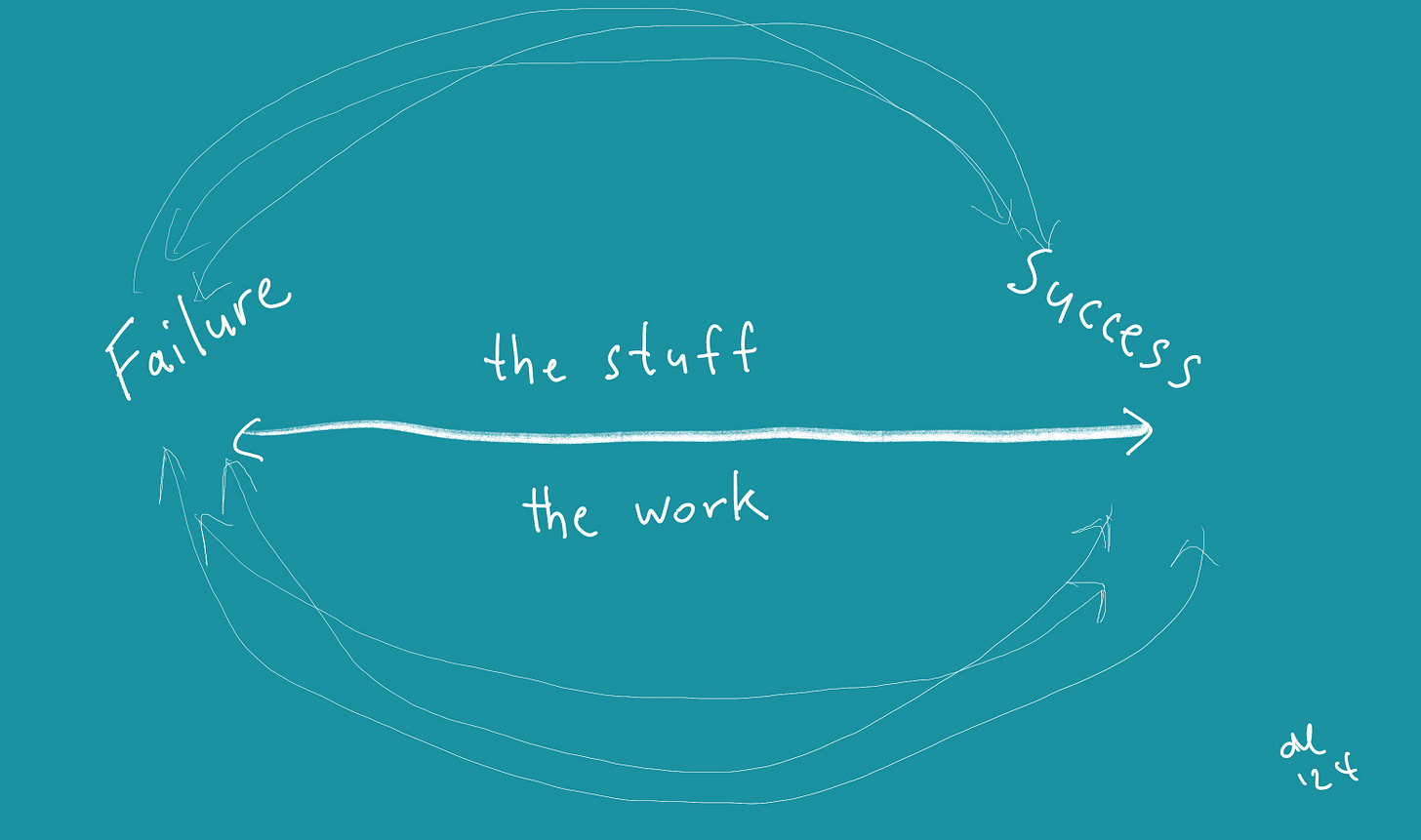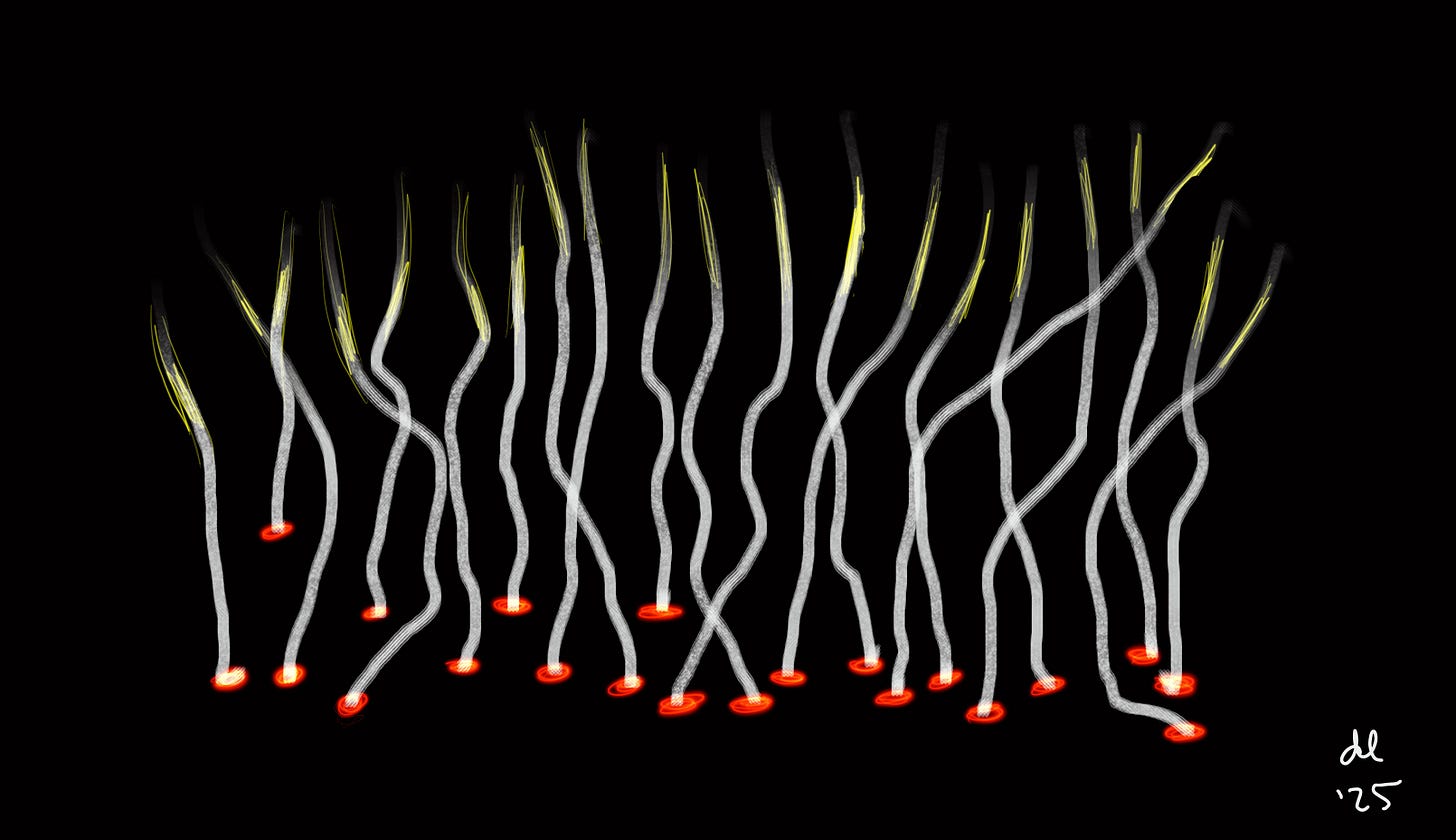How the Emotional Labor of Creativity Wears You Down (And Builds You Into Something New)
Box Cutter Co. Free Issue No. 85
My biggest struggles as a creative entrepreneur aren’t creative at all.
They were (and often still are) structural, and:
Invisible.
Relational
Emotional.
It’s stuff few people talk about in this work.
For example, when you leave structured employment—the 8 to 5, steady paycheques, hierarchy of expectations, etc.—you don’t just leave a job. You often leave a system.
A scaffold. A sense of built-in worth. And suddenly, you’re the one building it all — often from scratch.
Here’s what’s actually hard:
Letting go of external approval.
Creating without a guaranteed return.
Measuring value in integrity, not in analytics.
Staying in the work when metrics don’t move.
Learning to be your own source of momentum.
Saying “This is enough” when everything screams “scale up.”
This isn’t about imposter syndrome (a term that often pathologizes what’s systemic and, I feel, is a Bullshit term).
This is about identity. About disorientation. About unlearning mental and emotional infrastructures, we have been taught to rely on. Belief structures and beliefs that need re-visiting.
It’s about who you are without the feedback loops and about:
“What happens when you stop performing productivity and start practicing presence?”
And that’s terrifying for a lot of folks, especially high-functioning professionals.
You’re left asking: Who am I when no one’s watching?
And the problem isn’t creativity…
The problem is all the invisible conditioning that told you, or telling you, for example:
You’re only as good as your productivity.
Your value must be tracked and proven.
Creativity is a luxury, not a foundation.
And here’s what muddles things even further…
Most professionals still think creativity is for artists — like it’s flair. A side thing. A hobby.
But a real creative life?
It reshapes how you think, how you decide, how you build.
It’s not decorative. It’s foundational.
And it’s the engine of The Business Creator Economy (B2B) and the larger Creator Economy (B2C).
In this quickly expanding arena:
Visibility is strategy.
Systems are scaffolds.
Expertise becomes an asset.
Distribution becomes leverage.
Thoughtfulness becomes positioning.
But there’s a catch. It often doesn’t feel productive at first. If often doesn’t feel ‘productive’ even over the long term.
I’ve posted weekly on Box Cutter Co. for almost two and a half years. I’ve still not moved past 1,000 subscribers. (And I’m grateful nearly 10 of you support this endeavour as paid subscribers.)
Some metrics and evaluation gurus would see this as a waste of time and effort, like:
“Dude, terrible ROI!”
“Where’s your funnel?”
“Bro, you need to niche down.”
“You post every week for free?”
“Still under 1,000? After how long?”
“You should automate and scale that.”
“You could 10x this with the right offer!”
“Sounds like a passion project, not a business.”
And yet—I keep showing up. Thinking. Synthesizing. Writing. Posting.
Because the creative life I live and am actively building isn’t built on conversion rates or click-throughs. It’s being built on clarity, practice, and deep persistence.
This isn’t just content. It’s creative infrastructure.
Every post adds to a growing library. A long-term body of work. Each is part of a creative ecosystem—designed not for virality but resonance, reach and relationships.
I don’t know which post someone will find six months from now. Or which phrase might stick in their mind and make them reach out a year later?
But I trust the process.
I trust that this library of writing will work harder over time than any single viral hit ever could.
This work generates thinking, is generative thinking, and invites responses, engagement, and new friendships. This wouldn’t have happened if I didn’t post.
I notice what lands, what lingers, and what falls flat. I get to shape my ideas in public. Refine my frameworks.
👉 It helps to filter noise.
👉 It attracts conversations.
👉 It’s not passive marketing. It’s active meaning-making.
The ROI is often invisible, like:
A DM that turns into a deeper collaboration.
The subtle evolution of how I think, decide, and create.
A prospective client who says, “I’ve read everything you’ve written.”
The confidence that grows not from applause but from alignment (and simply doing the work)
I love writing. Not in the abstract. But the actual act.
The rhythm, structures, and overall puzzling of it. The surprise of clarity arising on a page, or in a post. Pressing “publish” still brings satisfaction. It hasn’t worn off, not after three years.
Not even close.
This isn’t a side hustle… It’s soul infrastructure.
And the only way it works is by showing up again, and again, and again.
What’s grown from my creative enterprises?
I own my calendar.
My energy is cleaner.
My thinking is sharper.
My conversations deeper.
I am less reactive. More rooted.
I feel more honest and connected in my work.
Because it’s not about output. It’s about orientation. I’ve also been able to build creative enterprises to revenues well beyond what I used to make as an employee.
And that brings me to the real shift—
It forces you to confront beliefs you’ve carried from corporate life, from schooling life, and maybe even from past family life, like:
Value = $$
More = better
Output = value
Busy = important
Meetings = momentum
A creative life dismantles all that, reveals much of the Bullshit. And makes space for many things that are deeper and real.
Not bigger. Not louder. Just clearer.
If you’re on the edge of choosing it— or already deep in it:
Don’t wait for permission. Don’t chase perfect timing.
Make something small and honest. Then, keep going.
Persistently. (Not just consistently.)
Because creativity isn’t the hard part.
Staying with it is.
What about you?
What mindsets from past structures still shape how you work today? Are they helping—or holding you back?
Thanks for reading, Box Cutter Co.
P.S. If this resonates, pass it along. Or leave a comment and tell me what staying with it looks like for you right now.






Wow, does this post resonate! I'm still in the process of unwinding myself from the structures of formal education and how my identity connected and disconnected form those structures during my 36-year teaching career as a Communication professor. Now that I'm retired, I'm grateful for the work I did and the impact it had on my students and myself as well as the benefits I derived from those structures such as my pension. Yet, in reading this particular post, it helped me understand why I struggled with certain aspects of the educational system and why I believe many aspects inhibited learning such as measuring success by how well students achieve pre-determined learning objectives (I get it. . . we want intentionality in teaching, yet I find objectives so limiting). Similar to you, I find our cultural emphasis on "productivity," "hustling," and the "gig economy" (more like "stuck in serfdom") to be bullshit. So, if I answer your question, "What mindsets from past structures still shape how you work today? Are they helping - - or holding you back?" I would probably answer "both/and" as I see "helping/holding you back" on a continuum, a dialectical tension. Sometimes those structures hold me back, sometimes they help me.
I'm currently completing a yoga teacher training program and working with two other yoga instructors to develop a series of workshops on yoga for educators. I believe practicing (and studying yoga) could benefit teachers in establishing presence and enable them to offer some activities to support students in developing presence as well. I see how the structures I employed in my classroom can help in building these workshops. I can also see how they can hold me back from unleashing my creativity.
I am also currently a certified Fearless Living Life Coach with a few clients, and employng my creativity has enabled me to help an autistic young man better understand his "quest" for a college degree and moving into adulthood using Dungeons and Dragons and allowing him to teach me about all about elements of the game as I've never played. Most surprisingly, using this framework, he's been able to talk about his family's dynamics and his role in a deep way that I don't believe he would have been able to do had I not used the framework of the game. I'm not sure I would have taken this approach had I not listened to students' speeches on the value of gaming for teaching problem-solving.
I'm also in the process of developing a short course (6-7 weeks) I'm calling Pace for Space to help participants re-envision work-life balance in terms of the pace at which one is moving (slow-moderate-fast) and how to make choices to support a sustainable pace. I developed this idea while keeping my "learning journal" that I learned about from you!
Thanks for all your inspiration!!